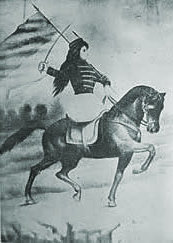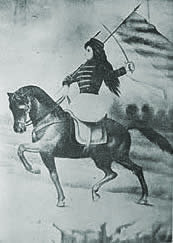
|
Women and Independence in Latin America An exploration of women's involvement in the Latin American Wars of Independence |

|

|
Women and Independence in Latin America An exploration of women's involvement in the Latin American Wars of Independence |

|
Other names: Empress of Brazil
Gender:Female
Ethnic origen: White
Events:
| 1797 | - | Vienna | - | Not applicable | - | She was born on 22 January 1797 in Vienna. |
| 1817 | - | Rio de Janeiro | - | Unknown | - | She married Dom Pedro I and lived here |
| 1817 | - | Vienna | - | Unknown | - | She married Crown Prince Pedro. |
| 1817 | - | Rio de Janeiro | - | Unknown | - | She arrived in Rio de Janeiro in November 1817. |
| 1826 | - | Rio de Janeiro | - | Unknown | - | She died here on 11 December 1826. |
Connections:
Bragança FamilyBiography:
Leopoldina de Habsburgo-Lorena was born on 22 January 1797 in Vienna and died 11 December 1826 in Rio de Janeiro. She was the daughter of Maria Teresa Carolina de Bourbon Nápoles and Francisco I of Austria. Her brother-in-law was Napoleon Bonaporte, whose second marriage was to one of her sisters, Maria Luísa (Schumaher & Brazil, 320). Leopoldina was educated at the Viennese court and took an interest in the natural sciences, particularly botany and minerology (Schumaher & Brazil, 320). Her marriage to the Bragança family heir to the Portuguese and Brazilian thrones, Crown Prince Pedro, was decided in 1817, reflecting the Portuguese royal family’s desire to form a union with a major European power of the Holy Alliance (Schumaher & Brazil, 320). In preparation for her new role, she met naturalists who had been in Brazil, learned Portuguese and worked at her music skills. She arrived in Rio de Janeiro in November 1817 and went to live with her new husband in the Palácio de São Cristóvão (Schumaher & Brazil, 323). She maintained regular correspondence, particularly with her family in Europe. She kept up her particular interest in the natural sciences and reorganized the Casa dos Pássaros which was later to become the Museu Nacional. In the field of politics she was a strong influence on Pedro to remain in Brazil when the rest of his family returned to Europe in 1821(Schumaher & Brazil, 323). In August 1822 when Pedro travelled to São Paulo, Leopoldina was given the regency of the country and presided over a session of the Conselho de Estado in which she determined the separation of the two countries, and had the ministers sign this record (Schumaher & Brazil, 323). Independence was officially declared shortly after in Pedro’s famous “Grito de Ipiranga”. Leopoldina was crowned Empress of Brazil in December that year and is credited in Brazil with being a major defender of Brazilian sovereignty and independence (Schumaher & Brazil, 323-4).
Although she was popular with the people, her relationship with Pedro deteriorated partly on account of his affairs, most notably his very public one with Domitila de Castro de Canto e Melo (Schumaher & Brazil, 324; Macaulay, 168-70). She was brought to court and promoted to a position as Mistress of the Bedchamber in the royal household. She aquired the title of the Marquesa de Santos, and Pedro legitimized his children by her. Leopoldina herself had seven children and was pregnant for the eighth time when she again assumed the regency in November 1826, because Pedro had gone to oversee the progress of the Cisplatine War (Macaulay, 201-3). She became seriously ill from eclampsia followed by miscarriage and scepticaemia. Her prolonged and painful death was, according to various accounts, worsened by the unwanted presence of her rival, Domitila de Castro, whom she tried to have removed (Schumaher & Brazil, 324; Macaulay, 202-3). She died on 11 December 1826 amidst immense popular mourning, and police feared attacks on the house of Domitila de Castro. Negative public opinion against Castro also contributed to the growing unpopularity of the Emperor who abdicated in favour of his infant son, the future Pedro II, in 1831 and returned to Portugal (Schumaher & Brazil, 324).
Much of Leopoldina’s correspondence is housed in the Biblioteca Nacional in Rio de Janeiro. She enjoyed a particularly strong and lively friendship with the British woman traveller Maria Graham who witnessed many of the events surrounding the declaration of independence in 1822 and briefly acted as governness to the royal family’s eldest daughter Maria da Glória, (who was then Crown Princess) in 1824. Translations of selected correspondence are reproduced in Jennifer Hayward’s 2003 edition of the Journal of a Residence in Chile in 1822 and provide a moving testimony to the personal and intellectual friendship between the two women which continued, after Graham had left Brazil, until the Empresses’ death in 1826 (Graham, 286-90).
References:
Schumaher, Schuma and Brazil, Érico Vital (editor). (2000) Dicionário Mulheres do Brasil de 1500 até a atualidade
Flores, Hilda Agnes Hübner (1999) Dicionário de Mulheres
Graham, Maria Hayward, Jennifer (editor). (2003) Journal of a Residence in Chile during the Year 1822, and Voyage from Chile to Brazil in 1823
Macaulay, Neill (1986) Dom Pedro. The Struggle for Liberty in Brazil and Portugal, 1798-1834